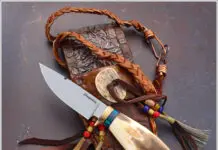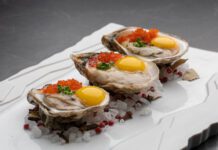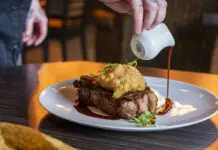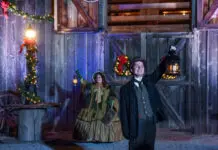Walk into the lobby of the Mayo Hotel and you’re surrounded by the opulence of a bygone era. Now the Mayo has food worthy of a hotel where presidents, tycoons and movie stars once rubbed shoulders. It’s served in a more casual setting just off the main lobby, a two-tier eclectic jumble of Art Deco molding, postmodern metal pipes and beams, and chairs adorned with frescoes of Prohibition-era flappers. Chef Jeff Meldrum, who spent eight years cooking at Southern Hills Country Club, has designed a menu of elegant, classic dishes that would have been acclaimed by the gilded long-gone elite that patronized the Mayo in its glory days. Sole Marguery, invented in Paris around 1890 and a favorite of gilded-era gourmand Diamond Jim Brady, features filet of sole adorned with crab, lobster, mushrooms, and a rich, bubbling French hollandaise. There are modern, cutting-edge entrees, too. A coffee-crusted filet mignon is topped with wilted shallots and a chipotle demi-glace. For those craving a lighter meal, small plates such as beef Carpaccio and oysters Acapulco round out the menu. 115 W. 5th St., Tulsa. www.themayohotel.com
Kansas City, Here We Come
Arriving early on a Friday evening permits the opportunity to check into your hotel and not have to miss an evening in cultural and cosmopolitan Kansas City, Mo. First you’ll want to experience the culinary king of KC, barbecue. Try the third-generation-perfected barbecue at Gates Bar-B-Q or the Zagat-praised Fiorella’s Jack Stack Barbecue. Feel free to indulge, because you can work off some of dinner’s calories at some of the highest energy nightlife venues in the city afterward. Dance at Marquee in downtown’s Power & Light District or enjoy a classic cocktail at the deliciously old-school speak-easy-inspired Manifesto in the Crossroads District. Czar Bar on Grand Boulevard downtown features live music and DJs in an environment both intimate and energetic. If your nocturnal travels take you to Westport late, check out the wine flights and eclectic menu at Firefly Lounge.
Grab breakfast Saturday morning at your hotel or enjoy the relaxed atmosphere at Happy Gillis or the equally friendly Cook Shack Café. You’ll need your strength for the day’s whirlwind tour of the city. Strategically map out the best route to visit Kansas City’s most colorful sites, such as the Jesse James Farm & Museum, Arabia Steamboat Museum, National Frontier Trails Center and Fort Osage National Historic Landmark. For high culture, the American Jazz Museum is a must-see, and you will want to stroll the Crossroads Arts District to get a look into the vibrant art heart of KC. Don’t miss The Nelson-Atkins Museum of Art, the Kemper Museum of Contemporary Art and the Nerman Museum of Contemporary Art. For an indulgent Saturday night dinner, pull yourself away from iconic barbecue and instead consider The American Restaurant, Kansas City’s only Mobil Four-Star Restaurant, or the acclaimed Progressive American culinary stylings at Bluestern. Your must-see evening jazz crawl should include visits to The Blue Room and The Phoenix Jazz Club. Definitely end up at midnight at the Mutual Musicians Foundation for the historic venue’s weekend “The 12 O’clock Jump” live radio program and general bacchanalia.
Sunday morning after breakfast, see the sites you missed on Saturday, plus the new handsome Kauffman Center for the Performing Arts, and check and see if any of the numerous annual festivals are underway. Otherwise wind down your visit with shopping at the City Market or Country Club Plaza, lunch and a farewell to KC.
Stay In Style
Kansas City has a broad range of accommodation types, including these options.
The Raphael Hotel is conveniently located in the Plaza district and renowned for quality of service and simple elegance. www.raphaelkc.com
The Hyatt Regency Crown Center is a traditional full-service hotel catering to conference guests, so it’s also buoyed by excellent staff, an impressive array of services and amenities and immaculate rooms. Grab an upper floor room for a terrific city view. http://crowncenter.hyatt.com
Q Hotel & Spa is Kansas City’s inclusive “green” hotel located in the heart of the city and complete with free amenities such as parking, wi-fi, yoga, breakfast, evening drinks and shuttle service to area attractions. Affordable accommodations range from clean and simple to the stellar Special Occasion Suite. www.theqhotel.com
At A Glance
Kansas City has been dubbed “Paris of the Plains” as well as the “City of Fountains” for its 200-plus fountains located around the city. Situated opposite of Kansas City, Kan., the surprisingly cosmopolitan city is well-known for its contributions to the musical styles of jazz and blues as well as to cuisine (Kansas City-style barbecue).
Access: Although just a few hours easy drive from most of Oklahoma, Kansas City is also served by most major American carriers via Kansas City International Airport.
Population: Approx. 460,000
Climate: Located not far from the middle of the country and sitting at the confluence of the Missouri River and Kansas River, Kansas City’s weather is entirely seasonal with its most extreme weather at the height of summer and winter.
Main Attraction: Arts and culture abound in the Paris of the Plains, including a new performing arts theater, numerous art and history museums and music venues that conjure the original jazz era. Nightlife and dining resemble those of larger, cosmopolitan cities back east.
Hot Picks
Shop: For more than 150 years, KC’s City Market has linked local growers and small businesses to city residents. Consider a weekend morning visit for a vibrant farmers market, but there are also numerous fulltime vendors.
Eat: The Golden Ox (www.goldenox.com) is Kansas City’s most famous steakhouse and conjures memories of when KC was home to the second largest stockyards in the country (after Chicago).
Fest: Beginning in September and running for almost three months, American Royal is an annual celebration originally inspired by agriculture but now encompassing everything from a launch parade to equestrian events, shows, balls and special events that accentuate KC and Great Plains life and history.
Visit Online
www.visitkc.com
Sports: Oklahoma City Barons Hockey
It’s been a year since the Barons debuted as Oklahoma City’s official hockey team, and the American Hockey League affiliate of the Edmonton Oilers. Some might guess that the hard part – the first season – is over. When you consider the expectations built up over the course of a year, fans gained and the team’s status as a top development league for players rising in the sports ranks, the Barons have a challenging season ahead. When it comes down to it, the object of the sport from the Barons’ point of view is as much about continuing the momentum as it is scoring on the ice. The team opens its 2011-12 season on the road with an Oct. 9 game against the Texas Stars. Be prepared when the Barons bring it home Oct. 15 to the Cox Convention Center to play the Stars once again. Also look for some hometown action on Oct. 16 with the Houston Aeros. For a look at the season schedule and other information, go to www.okcbarons.com.
A Warrior For Others
I founded the Oklahoma Brain Tumor Foundation after my 18-month-old son Cade died from a brain tumor in 2000. He was diagnosed at six weeks old, and there wasn’t anybody on a community basis to help me, to provide resources or financial assistance, to say, “Have you done this? Have you looked here?”
After Cade died, I immediately began working with families affected by brain tumors. I held my first support group meeting in April 2000. My initial intent was to be a support system for families who were going through what I went through. I likened it to being in a dark room, searching for a light switch, but no one was there to provide help or turn the light switch on for me. I wanted to provide that for these other families. When my son was sick, we lost almost everything we had. There are so many families that don’t have a family that is in a position to help them financially. Some families end up homeless because they can’t afford to pay rent or bills. The Oklahoma Brain Tumor Foundation developed into providing all of these different services that came out of my personal experiences.
I am extremely proud of what we provide for our families. We have patient navigators on staff that help families overcome whatever challenges they’re facing. We are able to work with families and put support services and assistance in place, so the family can concentrate on taking care of their loved one as much as possible. It’s great to raise money for research and educational resources and support groups, but what families need is someone that’s going to hold their hand and walk through these processes and take lots of stress off their plate. There is such a need for the type of services we provide; we hope other organizations start to provide services for immediate needs.
I feel very blessed that I was entrusted with something as important as these families’ lives and this organization. I feel blessed that I had that little bit of time with my son, because he was an amazing little boy. I feel blessed to be able to work with these families every day and see the impact that our staff members are able to have in these families’ lives and the relationships that are built. Everybody always says, “How can you say that when your son died?” The reality is that he didn’t die for nothing, and there have been hundreds of families whose lives have been made better because of this one little boy who suffered with a terrible disease. Because of that, so many people have been helped. Just to be a part of that is an amazing thing.
Fro-Yo CEO
Former University of Oklahoma football player Reese Travis is the CEO of Orange Leaf Frozen Yogurt. Based in Oklahoma City, the successful Orange Leaf has opened more than 80 shops over the last two years. Frozen yogurt fans can find Orange Leaf across the country, and soon they’ll be able to get their frozen yogurt fix in Australia, too.
Oklahoma Magazine: You’re turning frozen yogurt into cash, but you’ve proven yourself as an entrepreneur; you could probably be turning other things into cash. Why frozen yogurt?
Reese Travis: When we began our involvement with Orange Leaf, we were just a franchisee. We thought, hey, let’s do a few of these stores. The model is easy to reproduce. It’s a high-quality product. It’s very profitable. And it’s a fun, family experience. When we were still at the store level, we thought, “Let’s take this small chain, put our business practices to use and capture the momentum of the yogurt industry.”
We thought we had momentum when we started, but our momentum now is incredible.
Yogurt Capital of the World?
What is it, 1985 again? Frozen yogurt is everywhere these days, and Oklahoma companies are banking on the trend. In addition to Orange Leaf, Tulsa-based FreshBerry now operates more than 30 franchises in eight U.S. states, Bahrain, Saudi Arabia and Venezuela. Broken Arrow-based CherryBerry is rapidly expanding its franchisee base to dozens of locations in 20 states.
OM: I’ll be hunting down some Orange Leaf tonight. What flavor am I having?
RT: I’m on this big kick right now. I used to do three flavors. Always chocolate, peanut butter and then I’d do one of the decadent flavors like wedding cake, birthday cake, cookies and cream or cheesecake. And I’d go for a hodgepodge of toppings. Now I get a tart flavor and I top it with granola and cocoa pebbles.
OM: That’s good. It’s good to experiment.
RT: It’s fun to watch our Facebook page. People will say, “I thought that was my favorite but you guys came out with a new flavor and now that’s my favorite.”
People like to mix it up. Our customers have a lot of fun with that.
OM: You’re even expanding into the Land Down Under. You’re worldwide. How’s that feel?
RT: There’s nothing like Orange Leaf over there. We’re getting a lot of interest. People are lined up down the road wanting to try it. It should be pretty exciting to see what happens in Australia. Obviously, we won’t have a problem with the language barrier, and that makes it easy, as well.
OM: Why will Orange Leaf still be serving up the good stuff in 50 years?
RT: Our franchisees. At the end of the day, what makes Orange Leaf successful is our franchisees. When they open a store in their market and they get plugged into their communities, it works. They’re marketing to their communities. That’s really what makes Orange Leaf so successful. We’re really a community shop. That’s what’s going to keep us going. And, of course, we have the best frozen yogurt on the market.
OM: You had a great career as a football player at OU. I’ve heard that you lean on your experiences there for ideas and philosophies that you apply to your business.
RT: It’s very true. A lot of what I’ve learned is stuff I learned from playing football. I’ve had a lot of great coaches in my life that were great leaders that led by example. I played with a lot of teammates that I learned lessons from on a daily basis. My athletic career is really the foundation for what I do today, whether I’m at work or with my family. In athletics, philosophies are simple and a lot of them are based on having a good work ethic, discipline and dedication. I use all my sayings from those days around the office all the time. I’m sure my people get tired of hearing them but I’ve got a great group of team members up here. It is like having a football team. It’s like the locker room, where everybody is focused on the same goal and working hard. That’s the atmosphere I like to have here at work.
Hideaway Pizza
With humble beginnings as a staple in the college town of Stillwater, Hideaway Pizza has expanded its borders with multiple stores in both of the state’s metro areas and even into – gasp – Norman – solid Sooner country.
Now, the folks at Hideaway have opened perhaps their most groundbreaking restaurant in downtown Oklahoma City’s historic Automobile Alley district. This location is filling a niche as a reasonably priced lunch destination for downtown workers; it’s also a hip eatery for those who live near Automobile Alley. The location is also the first Hideaway to offer a full bar, serving liquor in addition to beer and wine.
The thing that has remained constant with this location, however, is the menu filled with delicious pizza. Staples, such as the Big Country, a pie piled high with red sauce, meats and cheeses (which was also recently named the best pizza in Oklahoma by Food Network magazine) are on the menu, along with other meat- and veggie-laden pizzas. Hideaway is set to open another Oklahoma City location at McArthur Boulevard and Memorial Road in mid-to-late October. 901 N. Broadway, Oklahoma City. www.hideawaypizza.com
Simply Healthy
It is state fair time all over the country, and “purple cows” will be spotted everywhere. A purple cow is any strange combination of foods (usually laden with sugar, fat, salt and sometimes chocolate or caffeine) that are attractive because of the unnatural combinations and effect they provide. The effect is called a bliss point, which is that good feeling that happens when dopamine levels are raised and neuropathways opened to make you remember the yummy taste and good feeling. Caution: Treat purple cows like narcotics; they can become addictive.
Examples of purple cows with high bliss points are the doughnut cheeseburger, fried Kool-Aid balls, treats dipped in batter, fried and rolled in chocolate and double cheeseburgers with bacon, honey and hot sauce. Examples of foods with high bliss points, but not necessarily considered purple cows, are chocolate doughnuts, energy drinks and French fries.
One way to enjoy food and lower bliss points is to notice the combination of sugars from carbohydrate foods, fat and salt and by deleting at least one of the components. Twice baked potatoes offer a great substitution example. Instead of making them with butter, sour cream, bacon and salt, you can substitute plain yogurt, fresh chives, onions, pepper, herbs and parsley to lower the bliss point.
Twice Baked Potatoes
Bake two potatoes until soft (in a 375-degree oven for about one hour). Cut in half lengthwise and scoop out the center. Mix in blender potatoes, 1/4 cup plain, authentic Greek yogurt, 1/8 cup chives and 1/8 cup onion. Add pepper and herbs to taste. Fill potato skins with mixture and bake again for 10-15 minutes. Garnish with fresh parsley and serve.
Outside The Box
The widespread appeal of clean, modern design has revolutionized the options available in fireplaces. Manufacturers have answered the call by replacing the old gas log with a sleek, simple ribbon of fire. The technology of the modern gas fireplace has changed the shape of the flame from the short rectangle of the traditional hearth.
Often housed in a shorter, wider firebox, the simple ribbon of flame utilizes a long linear look to add movement and drama to a room.
“The fire ribbon creates a fire with a longer, sleeker look,” explains Doug Campbell, owner of Campbell Design Associates.
The simplicity of the technology and shape allows for a lot of customization, adds Chris Murphy, owner of Christopher Murphy Designs.
“In this world where everything is homogenized, people want something that’s their own. With this style, the sky is the limit,” says Murphy. “You are only really limited to what the mind can dream up.”
After seeing the new sleek, modern style of gas fireplaces all over design magazines, Campbell was drawn to a model from Spark Modern Fire for its look and the low maintenance it offers. In Campbell’s own townhouse, the living room is upstairs.
“I didn’t want to have to haul logs upstairs,” remarks Campbell.
Campbell chose a vented, stainless steel firebox and had a local fabricator create a stainless steel surround that Campbell designed.
High design doesn’t necessarily come with a high price tag, Campbell and Murphy agree.
“They appear to be similar (in cost),” says Campbell. “Maybe slightly more expensive because the sleek, clean styling takes more time and craftsmanship than traditional styles.”
“The cost depends on what you choose and whether it’s new construction or a remodel,” agrees Murphy. “But, they are fairly comparable to a traditional fire box.”
The impact and flexibility of the design of the modern firebox provides for a variety of uses. You can choose a larger scale fireplace to make a bold statement and be the focal point of your space, explains Murphy. Or, you can go with a smaller scale to make the fireplace a cohesive part of your design.
Murphy adds that with a range of customization options, the fireplace can be more than just a functional part of your home.
“(Your fireplace) can be a living, breathing piece of art,” offers Murphy. “Glass can add color and movement and it sparkles like diamonds. You can use various materials like mirrors or metals on the fire box back to give you depth and a reflective aspect.”
For even more flexibility, manufactures, like EcoSmart Fire, offer freestanding fireplaces without the need for pipes and plumbing installation. Models like the EcoSmart use an alcohol-based gas available at most hardware stores to power its flame.
“It provides a similar dancing flame but doesn’t require a gas connection,” says Campbell.
“This option works well in outdoor spaces as well,” adds Murphy.
The Art Of Tradition
Dating back more than 3,000 years, metalworking, particularly with copper, in the eastern part of the United States has mainly had a ceremonial and ritual significance.
With the new metalsmithing class at the Cherokee Arts Center in Canton, the ancient art form is making a comeback.
“To work copper from its raw form into the art objects produced prior to European contact makes it evident that there was a very good understanding of metallurgy and metal working techniques,” says class instructor Toneh Chuleewah.
“As a modern metal worker, I have a great appreciation for the skill involved in the production of their pieces, considering what I envision they had as tools to work with as compared to what I use today.”
The class, which has a waiting list for enrollment, is aimed at teaching metalworking techniques, while giving budding entrepreneurs the extra tools to create a sustainable business.
“We hope to educate the public on our tribal designs and materials and ultimately, we hope to assist the artists to grow their art businesses to the point that they open their own studio and gallery someday,” says Donna Tinnin, event organizer for the Cherokee Nation Community Tourism.
“We have some of the most talented Cherokee artists right here in our communities, and we want the world to see and enjoy their work.”
Housing affordable studio space, as well as shared services such as computer and internet access, and other business related infrastructure, the center aids artists in every aspect of developing their artwork.
“The Native Artists Professional Development curriculum will be provided throughout the year,” says Tinnin. “We also have an artist loan program that allows us to offer low interest loans to artists in order to enhance their current business, or just to purchase materials in order to create inventory.”
And with all of these tools offered for students, their main focus can stay with their craft – and making it their own.
“There are many similar characteristics in copper work with tribes throughout the Southeast, as copper was a shared art form, but each tribe has its own unique take on the images within its own cultural beliefs,” says Chuleewah. “Though I am a second generation jeweler, my style is completely different from my father’s, even though he was the one who taught me.”
But the consistent root of this art form is its historical and cultural significance, and that retains a great influence on modern metalworkers.
“One of the aspects that has fascinated me about metal work, is that the art I have made will far outlast my existence, for generations to come,” says Chuleewah.
And it is those generations who will learn from their ancestors and grow along the way, just as present Cherokee metalworkers are learning from their ancestors today.
The skill and craftsmanship of these artists is just as important as the products they are producing.
“One of the main significant aspects of this art form is its durability,” says Chuleewah. “It will be a record of our culture that will last far into the future.”
A Filmmaker’s Foray
Amina Benalioulhaj is obsessed with the intersection of women and prisons. These are the stars of the 21-year-old University of Oklahoma student’s documentary, Women Behind Bars, which focuses attention on Oklahoma’s failure to address the nation’s highest female incarceration rate.
Benalioulhaj says she was shocked into action when she learned of the state’s overcrowded women’s institutions.
“I decided I needed to do something to inform my peers and Oklahomans at large,” says Benalioulhaj.
Women are incarcerated at twice the national average in Oklahoma, including many for non-violent crimes, usually drug-related. Possession of small amounts of marijuana, for instance, could land a woman in jail in Oklahoma for a long time. In most states, it’s a minor offense.
Benalioulhaj distills personal stories into a powerful statement – no easy feat for a first-time filmmaker. Benalioulhaj financed the film herself to the tune of roughly $6,000. She taught herself the technical aspects of filmmaking. She and her crew relentlessly threw time and effort into the project.
It paid off. The film was an official selection at Oklahoma’s deadCenter Film Festival this year. But more importantly, its many screenings are raising awareness about the problem.
Benalioulhaj credits the work of Dr. Susan Sharp, an OU sociologist, for her inspiration. For more than 10 years, Sharp’s been following the lives of Oklahoma’s incarcerated women. Sharp’s work fired Benalioulhaj’s imagination – and gripped her conscience.
“I approached Dr. Sharp and asked her if I could use her research and if she could help me get my foot in the door with the Oklahoma Department of Corrections. I wanted to document the experiences of these imprisoned women. She was open to the idea from the beginning and it took off from there,” she says.
At times Women Behind Bars goes beyond chronicling lives of its subjects to map the web of social problems caused by Oklahoma’s excessive female incarceration rate. When mothers go to prison, families implode. Many of these women are single mothers. After the gavel hits the bar, those women’s children are placed in the custody of the Department of Human Services and later in foster care. Massive disruptions like this aren’t conducive to the rigorous pursuit of an education. And uneducated kids are more likely to turn to crime.
The film hits the mark with its primary goal – raising awareness. But awareness alone doesn’t bring real world change. Change, says Benalioulhaj, will come when people pressure legislators to refine the laws that stuff women’s prisons beyond capacity. Less incarceration of non-violent female offenders would significantly reduce the state’s female prison population, she says.
Many of these women sit in jail cells for drug-related charges. Many of them will return to prison repeatedly unless the system treats the root problem – drug addiction. And, she says, Oklahoma’s high poverty rate exacerbates each and every one of these conditions.
Benalioulhaj’s interest in the subjects of her movie won’t end when the curtain comes down. She aspires to work directly with them after she graduates.
“My interest is yoga therapy. I would like to take that into the prisons and work with the women,” she says. “My hope is to provide emotional healing and therapy for them.”























